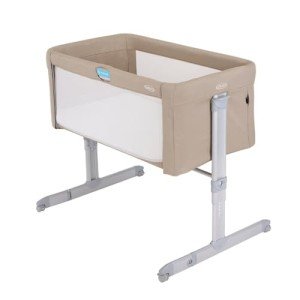The Importance of Bedside Cots for Infants: A Comprehensive Guide
As new parents embark on their parenting journey, they are faced with a myriad of options concerning their infant's sleep arrangements. Among these options, the bedside cot stands apart for its myriad of benefits. This short article checks out the significance of bedside cots, discusses their benefits and downsides, answers regularly asked questions, and includes a comparative table to assist parents make notified decisions.
What Is a Bedside Cot?
A bedside cot is a sleep space designed to be positioned beside the parents' bed, permitting easy access to the infant throughout the night. These cots feature adjustable height settings, allowing them to line up with the height of the adult bed. Frequently, they can be connected firmly to the bed or remain close by, providing a safe yet accessible sleep environment for the baby.
Kinds Of Bedside Cots
- Co-Sleeping Cots: These cots attach securely to the parents' bed, enabling close distance while guaranteeing the baby has their own safe sleeping space.
- Freestanding Cots: These are positioned beside the bed however do not connect directly. Bedside Cot For Close Bonding offer a convenient grab feeding and reassuring.
- Portable Cots: These cots are light-weight and created for travel, frequently featuring collapsible designs and easy-transport abilities.
Benefits of Using a Bedside Cot
Bedside cots supply several advantages that can improve both the infant's sleep experience and the parents' peace of mind. These include:
1. Boosted Safety
According to the American Academy of Pediatrics (AAP), having the infant sleep in the exact same room as parents, without sharing the same sleeping surface area, considerably lowers the threat of Sudden Infant Death Syndrome (SIDS). A bedside cot uses a safe space while preserving proximity.
2. Easier Nighttime Care
When a baby is within arm's reach, feeding, diaper modifications, and soothing becomes much more convenient. Parents can quickly soothe their infant without totally waking from sleep or leaving the bed.
3. Motivation of Bonding
The close proximity supplied by a bedside cot encourages bonding during nighttime feedings or comforting. This can foster a sense of security for the infant and assistance develop more powerful emotional connections.
4. Space-saving Design
Numerous bedside cots are designed to be compact, making them ideal for small home where a full-sized crib might not fit. They can be quickly moved or saved when not in use.
5. Versatile Functionality
A lot of bedside cots can be adjusted in height and frequently feature detachable sides, making them versatile for numerous uses as the child grows or household needs change.
Drawbacks of Bedside Cots
Regardless of their advantages, there are some downsides to consider when choosing a bedside cot:
1. Limited Lifespan
Bedside cots generally have a shorter life expectancy than basic cribs, often accommodating infants only up to a particular weight or height. Parents might require to shift to a complete crib earlier than expected.
2. Stability Concerns
If not firmly connected or correctly placed, a bedside cot might posture safety issues. Parents need to make sure that the cot is steady and well-aligned with the bed.
3. Adjustment Period
Some infants might take time to get utilized to sleeping in a cot, particularly if they are utilized to closer contact. Parents may need to be patient as their kid adapts.
How to Choose the Right Bedside Cot
When picking a bedside cot, parents must think about the following criteria:
- Safety Standards: Ensure the cot abides by all security regulations.
- Adjustability: Look for height-adjustable functions that align with your bed.
- Construction Material: Choose a cot that is sturdy and made of non-toxic products.
- Relieve of Use: Opt for designs that permit one-handed operation when accessing the infant.
Table: Comparison of Popular Bedside Cots
| Feature | Co-Sleeping Cot | Freestanding Cot | Portable Cot |
|---|---|---|---|
| Attachment to Bed | Yes | No | No |
| Adjustability | Yes | Yes | Yes |
| Travel-Friendly | No | No | Yes |
| Lifespan | 6-12 months | 18-24 months | 0-12 months |
| Rate Range | ₤ 150-₤ 300 | ₤ 100-₤ 250 | ₤ 50-₤ 150 |
Frequently Asked Questions (FAQs)
1. Are bedside cots safe for my baby?
Yes, when used properly and according to safety requirements, bedside cots are safe for infants. It is crucial to make sure that the cot is securely located and does not present any threat of falling.
2. At what age can I shift my baby from a bedside cot to a crib?
A lot of parents transition their baby from a bedside cot to a crib in between six months and 2 years, depending upon the infant's development and comfort level.
3. Can I use a bedside cot for twins?
While some bedside cots are developed to accommodate more than one child, a lot of are planned for single infants. Parents of twins might require to consider using different cots.
4. How do I maintain my bedside cot?
Routine cleaning, looking for wear and tear, and guaranteeing that all elements, such as security straps and bed mattress, are in good condition, can help maintain your bedside cot.
Selecting the best sleep arrangement for an infant is among the many choices that new parents deal with. A bedside cot provides unparalleled convenience and security while enabling close adult interaction. Understanding the benefits, downsides, and features of bedside cots can empower parents to make the ideal option for their family's needs. By weighing these factors alongside safety precautions, parents can create a nurturing sleep environment for their youngsters.

